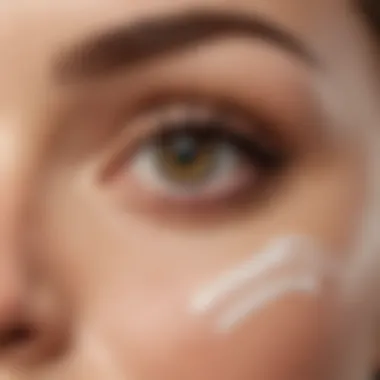Morning and Night: Top Eye Creams for Your Routine


Intro
The eye area often demands special attention in skincare routines. Morning and night eye creams are essential to address specific concerns such as puffiness, dark circles, and fine lines. The skin around the eyes is more delicate and thinner than the rest of the face. Hence, the right formulations with effective ingredients can make a notable difference.
In this article, we will explore key trends in eye creams, offer beauty tips tailored for different skin needs, and highlight sustainable practices in beauty care. Understanding these components is vital for anyone looking to optimize their skincare regimen.
Each section will provide insights to help you make informed choices about your eye creams. Knowledge of how to select and apply these products is crucial, enabling readers to enhance their skin health and appearance. This deeper look into eye care serves not just aesthetic purposes but also promotes overall skin vitality.
Understanding the Need for Eye Cream
The delicate skin around the eyes deserves special attention. This area is thinner and more sensitive compared to the rest of the face, making it susceptible to various issues. Skin care with targeted products can yield significant benefits, providing hydration, reducing puffiness, and minimizing signs of aging. Eye creams are formulated specifically to address these concerns, offering potent ingredients that can penetrate deep into the skin layers. Choosing the right eye cream is essential for maintaining a youthful and vibrant appearance.
The Anatomy of the Eye Area
Understanding the basic anatomy of the eye region can help in selecting the most effective eye creams. The skin around the eyes is about 40% thinner than on the cheeks. It has fewer glands, meaning it produces less natural moisture. Furthermore, this area contains a network of blood vessels close to the surface, which contributes to issues like dark circles or puffiness. Given these characteristics, products designed for this area need to be gentle yet effective.
Common Issues Faced by the Eye Area
Several common issues plague the eye area. Each of these concerns can affect overall appearance and confidence, highlighting the importance of addressing them.
Dark Circles
Dark circles result from various factors such as fatigue, genetics, and aging. They are characterized by a shadowy look beneath the eyes, which makes people appear tired or older than they are. In this article, dark circles are significant as they are a prevalent concern for many individuals. Their identification helps to tailor specific solutions that can brighten the eye area. A key feature of dark circles is their persistence; they often do not respond quickly to treatments. This characteristic makes finding effective products even more crucial.
Puffiness
Puffiness is another common problem that often arises from lack of sleep, allergies, or fluid retention. This issue results in a swollen appearance that can make one look weary. For readers, knowing about puffiness is beneficial because it is often reversible with proper care. Unlike dark circles, puffiness can sometimes be alleviated quickly with specific ingredients. The unique feature of puffiness is that it can be dramatically improved with instant remedies, making products that target this concern popular choices.
Fine Lines and Wrinkles
Fine lines and wrinkles appear over time due to a loss of collagen and elastin in the skin, leading to a sagging appearance. This concern adds to the visibility of dark circles and puffiness, making it critical to address all three together. Fine lines are notable because they are early indicators of aging; addressing them can prevent more extensive wrinkle development later on. The unique aspect of fine lines is their gradual appearance, emphasizing the importance of early intervention. Effective eye creams may contain ingredients that promote collagen production and enhance skin elasticity, providing tangible benefits to users.
Each of these issues underscores the necessity for dedicated eye creams. By understanding the specific problems faced in the eye area, users become equipped to find solutions that effectively cater to their unique needs.
Criteria for Choosing Eye Creams
Choosing the right eye cream is essential for the health and appearance of the delicate eye area. The skin around the eyes is thinner and more sensitive than the rest of the face, requiring specialized care. Understanding what makes a good eye cream involves considering multiple criteria. These criteria include identifying your skin type, understanding key ingredients, and being aware of any allergies or sensitivities.
Selecting an eye cream tailored to your specific needs can significantly improve issues like dark circles, puffiness, and fine lines. Moreover, it is important to note that not all products work for everyone. Careful consideration regarding the properties of a cream can lead to better choices and more effective results.
Identifying Skin Type
Dry
Dry skin is a common concern that affects many people. The main characteristic of dry skin is a lack of moisture, which can lead to flakiness and discomfort. Choosing an eye cream designed for dry skin often helps in maintaining hydration and elasticity. Hydrating ingredients, such as glycerin or ceramides, serve as beneficial components in these products. However, overly rich creams may lead to a feeling of heaviness or greasiness.
Oily
Oily skin produces excess sebum, often resulting in a shiny appearance. Acknowledging this, individuals with oily skin should look for lightweight, non-comedogenic eye creams. These products help control shine without clogging pores. A common and advantageous choice for oily skin is gel-based formulations. Nonetheless, overly light formulations may lack the moisture needed for optimal skin health.
Combination
Combination skin features both dry and oily zones. This type often shows characteristics of dryness around the eyes while maintaining oiliness in other areas. An eye cream formulated for combination skin should ideally balance moisture and oil control. Creams with a hybrid texture are often most suitable. However, finding the right balance can be tricky, and some products may not offer sufficient hydration for the drier areas.


Understanding Ingredients
Peptides
Peptides are small chains of amino acids that play a crucial role in skin function. They signal cells to produce collagen and elastin, essential for maintaining the firmness of the skin. This attribute makes peptides a popular choice in eye creams. Their unique ability to enhance skin elasticity can lead to visible improvements in fine lines. However, results are typically gradual and require consistent use to become noticeable.
Hyaluronic Acid
Hyaluronic acid is renowned for its exceptional ability to retain moisture. It can hold up to 1000 times its weight in water, which is beneficial for maintaining skin hydration. Products containing hyaluronic acid can help plump the skin, making it a valuable component for eye creams aimed at reducing the appearance of dark circles. On the contrary, individuals should be cautious of formulations that don’t pair it with moisture-rich agents, as this could lead to dryness in low-humidity environments.
Caffeine
Caffeine is often included in eye creams for its ability to dilate blood vessels and reduce puffiness. Its stimulating properties may improve circulation, leading to a fresher look in the eye area. However, its effects can be temporary. Some may find that the sensation of caffeine in creams can be slightly drying, so it is best used in conjunction with hydrating agents.
Vitamin
Vitamin C is a powerful antioxidant that protects the skin from free radicals while promoting collagen production. Its brightening properties make it a favorite among individuals looking to diminish dark circles. Vitamin C-based eye creams can provide a significant boost to overall skin tone. However, it is also important to note that high concentrations can irritate sensitive skin, so starting with a lower concentration is advisable.
Retinol
Retinol, a derivative of Vitamin A, is touted for its ability to reduce fine lines and improve skin texture. It aids in speeding up cell turnover, making skin appear smoother over time. For those looking to tackle aging signs effectively, retinol-infused eye creams are a good choice. Yet, it is crucial to start with a minimal dose to avoid irritation, especially for sensitive skin.
Allergies and Sensitivities
When selecting an eye cream, awareness of allergies and sensitivities is vital. Individuals prone to allergic reactions should seek out hypoallergenic formulations. Many creams include fragrances or preservatives that could irritate sensitive skin. Always checking the ingredient list before purchasing can help in avoiding problematic reactions. Consulting a dermatologist can also provide personalized advice tailored to unique skin needs.
Best Eye Creams for Morning Use
When it comes to our daily skincare routine, the morning is a crucial time to apply eye cream. This is where the delicate eye area needs energizing and protection against daily environmental aggressors. A well-formulated morning eye cream can significantly uplift the tired appearance of the eyes. It not only hydrates but also preps the skin under the eyes for makeup application. Choosing the right one can offer benefits beyond hydration, including brightening and minimizing puffiness, making this step essential for a refreshed look.
Formulations That Energize
Morning eye creams often include specific formulations designed to awaken and revitalize the area. These formulations typically balance hydration with added energizing properties. A gel or lightweight cream is preferred as it absorbs quickly, avoiding any greasy residue that may interfere with makeup. The right consistency should not only feel refreshing but also prepare the skin for the day ahead.
Ingredients to Look For
The right ingredients can enhance the effectiveness of morning eye creams. Here are two of the most vital components:
Caffeine
Caffeine plays an important role in morning eye creams. It is renowned for its ability to constrict blood vessels, leading to reduced puffiness. This quality makes it a popular choice for those seeking a quick solution to tired eyes. Caffeine can also provide a slight brightening effect, making it an effective ingredient in energizing formulations. However, it is crucial to ensure that the concentration is adequate for desired results, but not so high as to cause irritation for sensitive skin.
Vitamin
Vitamin C is another key ingredient that brightens the eye area. It helps in minimizing dark circles and improving overall skin tone. The antioxidant properties of Vitamin C protect the skin from free radical damage throughout the day. This quality makes it notable in morning formulations. However, Vitamin C needs to be stable in the formulation, which can sometimes be a challenge. Users should also check the packaging to ensure it protects against light and air, which can degrade its effectiveness over time.
Product Recommendations
Selecting the right product can be daunting with so many available options. Below are three notable brands that provide effective morning eye creams:
Brand A
Brand A is well-known for its commitment to quality and efficiency in skincare. Its morning eye cream features a blend of caffeine and other natural extracts that hydrate and energize the skin. A significant aspect is its lightweight formula that absorbs quickly, making it suitable for use under makeup. However, some users may find that the price point is higher than other products, although many consider it worth the investment.
Brand B


Brand B has gained attention due to its innovative use of ingredients. Their eye cream includes Vitamin C along with caffeine, effectively addressing puffiness and brightness. The cream has a slightly thicker texture compared to others, which some may prefer for added hydration. However, those with oily skin may want to test it first as it might feel heavy for some.
Brand
Brand C’s formulation stands out with its all-natural approach. This cream combines botanical ingredients with Vitamin C to nourish and protect the skin. Its eco-friendly packaging is an additional attractive feature for environmentally conscious consumers. However, if rapid results are the priority, it may take longer compared to synthetic options.
Best Eye Creams for Night Use
Nighttime is a critical period for skin restoration. During sleep, the skin engages in a self-repair process. Eye creams designed for night use provide specialized ingredients that target damage accrued throughout the day. The delicate eye area benefits from this dedicated care, ensuring rejuvenation overnight. It is essential to choose eye creams that focus on restoration to combat signs of aging and fatigue.
Formulations That Repair
Eye creams suitable for night use should contain formulations that emphasize repairing the skin barrier. Rich, thick creams are often preferred, as they create a barrier that locks in moisture. Many products use emollient-rich ingredients to deeply hydrate the skin, allowing it to recover. These formulations often include oils or butters, which help retain moisture effectively, leading to noticeable improvements by morning.
Ingredients to Prioritize
Retinol
Retinol is known for its powerful anti-aging properties. It enhances skin cell turnover and stimulates collagen production. This ingredient is particularly beneficial for reducing fine lines and wrinkles around the eye area. One key characteristic of retinol is that it is highly effective, but it can also be irritating for sensitive skin. When incorporating retinol into a nighttime routine, it is essential to start slowly and monitor for any adverse reactions.
Peptides
Peptides are chains of amino acids that promote healing and skin firmness. They work by signaling to the skin to produce more collagen and elastin. This is why peptides are highly considered in eye care products. They provide a non-irritating option that can improve the skin's texture and elasticity gently. While peptides are effective in improving visible signs of aging, they usually take longer to show visible results compared to more potent ingredients like retinol.
Product Recommendations
Brand
Brand D is known for its targeted night eye cream that combines retinol and peptides. This unique formulation ensures a dual approach to skin repair while promoting hydration. It stands out due to its lightweight texture that absorbs quickly into the skin. This brand’s approach helps to minimize irritation, making it suitable for a wide array of skin types.
Brand E
Brand E focuses on utilizing natural ingredients alongside peptides. This eye cream is praised for its soothing properties and ability to reduce puffiness effectively. The inclusion of botanical extracts enhances its appeal by providing antioxidant protection. Users report visible improvements in skin radiance and reduced dark circles, making it a beneficial choice for nighttime use.
Brand F
Brand F offers a luxurious eye cream specifically designed for night use. It combines retinol with a blend of hydrating ingredients that make it very effective in addressing dry skin. The richness of this product nourishes the under-eye area without feeling greasy. The drawback is that its higher price point may not suit every budget, but many find the results justify the investment.
"Choosing the right eye cream is just as important as the application techniques. The effectiveness of an eye cream largely hinges on its formulation and how well it meets individual needs."
In summary, selecting the best eye creams for nighttime requires attention to ingredients that facilitate repair and rejuvenation. Retinol and peptides are among the key components that deliver excellent results, providing both hydration and anti-aging benefits. Each brand offers unique features, catering to varied preferences and skin types.
Application Techniques for Eye Cream
Understanding the right application techniques for eye cream is crucial for achieving effective results. The skin around the eyes is delicate, and improper application can hinder the benefits of the product. Correct methods ensure that the cream absorbs properly and reduces the risk of irritation. Moreover, consistent application techniques can enhance the effectiveness of the ingredients within the eye cream. This section will discuss how to apply eye cream correctly and the recommended frequency for application to optimize care.
How to Apply Eye Cream
Applying eye cream requires specific techniques aimed at maintaining the skin's integrity. Start with clean hands and ensure your face is clean too. Here are the key steps:
- Use a small amount: A pea-sized amount of eye cream is sufficient. Using too much can lead to product buildup, which may cause irritation.
- Use your ring finger: The ring finger applies the least pressure. Gently tap the cream around the orbital bone, avoiding direct contact with the eyes themselves.
- Follow natural contours: Apply the cream along the under-eye area, moving from the inner corner to the outer corner, and then along the brow bone.
- Dab, don't rub: This tapping motion promotes circulation and lymphatic drainage, reducing puffiness and dark circles effectively.
It is crucial to avoid rubbing or dragging the skin, as this can contribute to fine lines and wrinkles. Instead, the tapping motion should feel light and soothing. This allows for maximal absorption of beneficial ingredients like peptides and hyaluronic acid without causing damage to the sensitive skin around the eyes.
Frequency of Application


The frequency of applying eye cream can vary based on the specific product and individual needs. However, general guidelines recommend:
- Morning and Night Routine: For optimal results, use eye cream both in the morning and at night. This routine helps maintain hydration and address issues such as dark circles and fine lines around the clock.
- Time it Right: Integrating eye cream into your skincare routine after cleansing and before moisturizing allows for the cream to work effectively.
Consistency is key. Evaluating the skin’s response to the product is important. Over time, adjust the frequency or the type of cream based on how your skin reacts. Depending on the formulation, some individuals may prefer a hydrating cream in the morning and a reparative cream at night. This personalized approach can enhance results and contribute to sustained eye health.
Therefore, adopting both proper techniques and a consistent application schedule is paramount for achieving desirable outcomes with eye cream. It ensures the delicate skin around the eyes receives all the benefits these specialized formulations can offer.
Evaluating Your Eye Cream Effectiveness
Evaluating the effectiveness of your eye cream is essential for achieving desired results in your skincare routine. The area around the eyes is sensitive and can show signs of aging or fatigue more quickly compared to other parts of the face. Hence, determining whether the eye cream you have chosen is fulfilling its purpose is crucial. Being able to assess the performance of your eye cream not only maximizes your investment but also optimizes your overall skincare efforts.
While many products make bold claims, a discerning evaluation will help you differentiate between effective solutions and those that fall short. This section explores what signs to look for when gauging improvement and discusses when it might be necessary to change products for better results.
Signs of Improvement
Recognizing signs of improvement is key to understanding your eye cream's effectiveness. Consider the following indicators that your eye cream is working well:
- Reduction in Puffiness: If you notice that morning swelling is less pronounced, it suggests the cream is effectively targeting fluid retention.
- Diminished Dark Circles: A visible lightening of under-eye darkness can indicate that the ingredients, like caffeine or vitamin C, are producing results.
- Smoothing of Fine Lines: Over time, a decrease in the depth of fine lines and wrinkles is a strong sign that your product is nurturing skin elasticity.
- Improved Hydration: Skin that feels more hydrated and plump typically means that your cream is working to retain moisture, contributing to a healthier appearance.
- Lifted Appearance: A firmer and more lifted contour around the eyes signifies that your cream may be successfully stimulating collagen production.
"Skin improvement signals vary from person to person, so it's important to track your changes consistently."
Take time to monitor these effects regularly. It may be beneficial to document your observations to evaluate progress effectively over weeks or months.
When to Change Products
Changing eye creams may become necessary if you do not see the expected results after a reasonable period of use, typically around three months. Here are some considerations for when it might be time to seek an alternative:
- Lack of Visible Results: If you have monitored improvements and see little to no change in your eye area, it may signal that your current product is not effective.
- Adverse Reactions: Any irritation, redness, or burning sensations imply a sensitivity to the formulation. Switching to a hypoallergenic or fragrance-free option might be necessary.
- Changes in Skin Condition: If your skin type changes or you develop sensitivities, adjusting products to better suit your current skin condition is advisable.
- Age or Environmental Factors: As one ages or if lifestyle changes occur, it might be necessary to explore products with targeted ingredients that address new concerns.
Choosing the right eye cream can take time and experimentation. Being attentive to how your skin responds to different formulations can lead to finding one that provides long-lasting benefits. Keep in mind, what works beautifully for one person may not necessarily yield the same results for another.
Sustainable Choices in Eye Care
In recent years, the conversation around sustainability has gained significant traction, influencing various industries, including skincare. The delicate eye area often requires special care, and incorporating sustainability into eye cream choices can provide numerous benefits, both for individuals and the planet. Sustainable practices in eye care focus on the sourcing of ingredients, the impact of production methods, and the overall ethos of the brands themselves. By prioritizing sustainable choices, consumers can ensure they are not only nourishing their skin but also contributing to broader environmental goals.
Choosing sustainable eye creams typically involves selecting products that use eco-friendly ingredients. These ingredients are often derived from renewable resources, minimizing environmental degradation. Moreover, sustainable packaging—such as the use of glass or biodegradable materials—reduces plastic waste, which has harmful effects on ecosystems.
Beyond individual benefits, sustainable choices can create a ripple effect within the beauty industry. Brands that focus on eco-friendliness often set higher standards for ingredient sourcing and formulations. This pressure can lead to more companies reevaluating their practices and committing to sustainable methods.
When selecting eye creams, it is crucial to consider certifications and brand claims. Verify if a product is cruelty-free, organic, or has been sourced ethically. Each of these aspects contributes towards making more informed choices and supporting companies dedicated to sustainability.
"Sustainability in beauty is no longer a trend; it's rapidly becoming a necessity. Consumers are demanding products that respect the planet and its resources."
Eco-Friendly Ingredients
Eco-friendly ingredients are at the heart of sustainable eye creams. These ingredients often have a lower environmental impact compared to their synthetic counterparts. Key elements to look for in eco-friendly eye creams include:
- Natural Oils: Ingredients such as jojoba oil, almond oil, and coconut oil are not only effective but are also derived from natural sources.
- Botanical Extracts: Plant-based extracts like chamomile and calendula offer soothing properties, while being biodegradable.
- Mineral-Based Components: Ingredients like zinc oxide serve as sun protectants and are derived from naturally occurring minerals.
- Sustainable Surfactants: Options like decyl glucoside, derived from corn, are gentle alternatives found in many formulations.
Incorporating these ingredients not only supports skin health but also aligns with principles of environmental stewardship.
Brands Committed to Sustainability
To further enhance your sustainable choices in eye care, consider brands that actively commit to eco-friendly practices. These brands often focus on:
- Ethical Sourcing: Ensuring that ingredients come from sustainable farms or suppliers who follow environmental regulations.
- Transparency: Providing clear information on their ingredient sourcing, production methods, and waste management.
- Minimalist Formulations: Reducing the number of ingredients not only simplifies their products but also reduces potential environmental impact.
Some notable brands leading the charge in sustainable eye care include CeraVe, known for their dermatologist-backed formulations, and Acure, featuring products with natural ingredients. Each brand has dedicated itself to sustainability while delivering effective results for the delicate eye area.
By choosing eye creams from these brands, you not only support your skin’s health but also contribute to a larger movement towards environmental responsibility in the beauty industry.
Birth certificate apostille. Work with over 100 foreign consulates.



